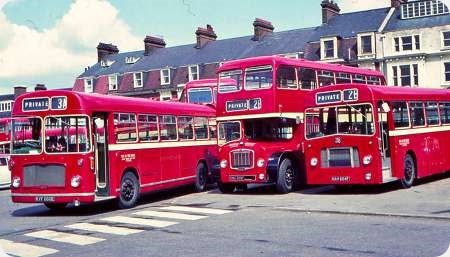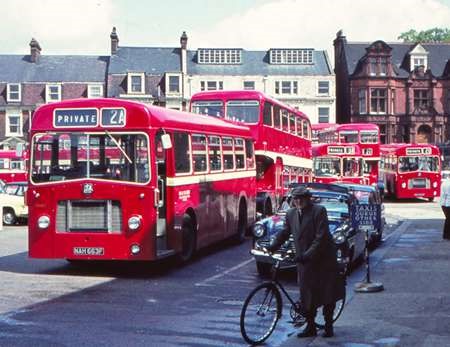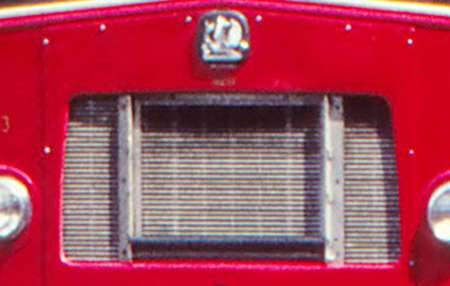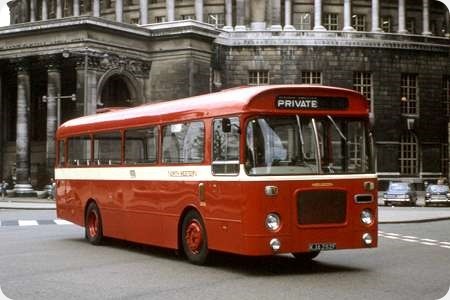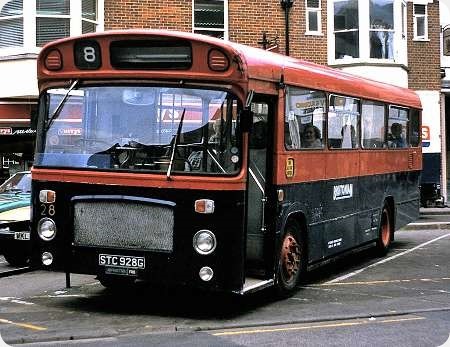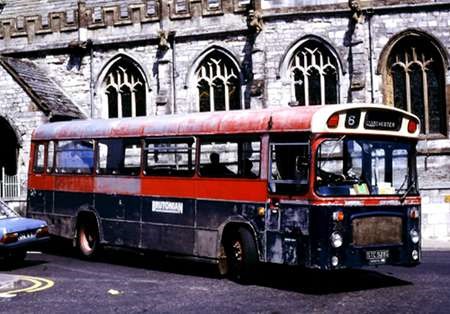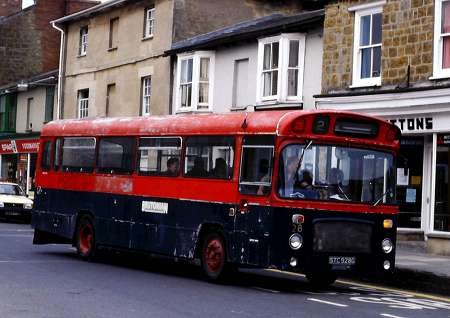Eastern Counties – Bristol RESL – KVF 660E – RS660
Eastern Counties Omnibus Co Ltd
1967
Bristol RESL 6HLX
ECW B46F
There are several non-ECW bodied RE buses featured on this site but few if any of the first Tilling Group RESL standard bus. This is RS660 (KVF 660E), the last of a batch of 14, which I believe was supplied to meet an outstanding order for MWs. The fact that they had 46 seats, compared to the maximum of 45 to date, didn’t prevent them being accepted immediately for one man operation, several based at the many outstations for which the company was famous. Alongside are FLF359 (ONG 359F) and SB664 (NAH 664F). A large number of recent deliveries, which the advert fixers had yet to purloin, were assembled in the forecourt of Thorpe Station, Norwich on Sunday, May 12, 1968 to meet an excursion train hauled by the Flying Scotsman. There were several tour options for passengers around the city and county before the return journey.
This period saw Eastern Counties explode from its long 4 and 5 cylinder era into that of the 6LX and 6HLX! The FLF found its way to Western SMT a couple of years later in the great FLF for VRT swop between National Bus Company and the Scottish Bus Group. The Bedford with ECW bus body was one of a batch of four, two with Bedford engines and this and SB663 (already shown on the same day in a Bedford VAM string in OBP) had Leyland engines.
Photograph and Copy contributed by Geoff Pullin
23/12/19 – 06:45
I believe that Eastern Counties’ next batch of RE buses were RELLs, and these were supplied with 6HLW engines, which were quickly swapped with the 6HLX engines from the RESLs.
Nigel Frampton
23/12/19 – 06:47
We had two Bristol RS’s at Cambridge. One of them was almost permanently on route 428 Cambridge station to Bedford. It was a long duty….two journeys….and was the only week on the rota that had two rest days for that reason. I worked it for a week when the regular driver was on holiday and enjoyed it immensely. The RS’s were super to drive…fast and powerful, and although they were rear engined, they had a very precise manual gear change, and a long gear lever. I also recall that they had a high pitched whine at speed from the transmission.
The other RS was usually on the 113 Cambridge to Haverhill and Kedington services, so they could inter change for maintenance and repairs. The RS’s were a vast improvement on the ordinary Bristol MW’s.
Norman Long
24/12/19 – 07:37
Nigel, I don’t think this is true. The first RELLs were in service in June 1968 (the month after the above photo) and I’m sure they had 6HLX engines as well. Although the company was adept at physically changing types of engine after years of downsizing double decks to 5 cylinders and much later installing a Gardner into a Leyland National, the change to 6HLX from 5HLW for buses was the policy introduced by the new General Manager who had arrived from Eastern National. In the 1960s, it was company policy to ‘fairly’ share new vehicles across the whole vast area, so, unlike today, sadly the advantages of better vehicles and performance didn’t reflect into timetables!
Geoff Pullin
24/12/19 – 10:05
The FLF would have had a 6LX engine also, although retaining a manual gearbox. All EC’s previous batches of FLFs having 6LWs.The former BCV test vehicle which they acquired in 1967 may have had a Bristol BVW initially.
Brian Crowther
25/12/19 – 05:52
Geoff, I must admit that I cannot remember exactly where I read about the engine swap – I think that it was in "Buses" magazine. However, the page on Rob Sly’s website for KVF 658E (the preserved survivor from this batch of RESLs) says that the engine was swapped during 1969.
//bcv.robsly.com/kvf658e.html
Other online sources say that it now has a 6HLX, so presumably it was changed again (or never changed at all!)
Nigel Frampton
25/12/19 – 05:53
Think the RESL at Carlton Colville has a 6HLW.
Roger Burdett
26/12/19 – 06:15
Nigel is correct, the 14 RESL’s 647 to 660 were delivered with 6HLX engines which were later replaced with 6HLW’s from RELL’s but without checking back I can’t confirm which RELL’s were delivered with 6HLW’s. I thought they may have been replaced with a later batch but as the first 14 RELL’s RL665 to 678 all had PPW registrations it’s possible that they were the donors.
Mark Ellis
28/12/19 – 06:18
Is the Bedford missing it’s front grille? It seems we are looking directly at the radiator without anything covering it.
Chris Barker
28/12/19 – 09:20
Looking at various photos of the four Bedfords in the batch SB661-664 (NAH 661-664F), the grille format appears the same on them all even after sale to other operators.
As Chris B says it does look very much like the grille is missing. Looking at photographs of the examples operated by West Yorkshire (4) and Western National (12), also new in 1967, all those seem to have more obvious grilles.
David Slater
28/12/19 – 15:10
This photo, taken on the same occasion, shows SB663 is fitted with a manually adjusted radiator blind in the traditional Bristol on-radiator fashion.
I don’t remember if this was ECW standard or an ECOC special.
Geoff Pullin
22/01/20 – 06:45
Not ECW norm-see www.old-bus-photos.co.uk/?p=30561
Stuart Emmett
23/01/20 – 08:56
In the close-up shot it would appear that the grille on the VAM has been set back from the front panel to allow for the fitting of a radiator blind. Whether this was fitted ‘in build’ by ECW at Lowestoft, or done by Eastern Counties themselves I’ll leave it to the ECOC experts.
Brendan Smith
18/02/20 – 07:30
The RELLs with 6HLW units were RL703-7 and 710-8 from the 1969 order, the engines being exchanged at ECOC before the chassis headed to ECW for bodying. KVF 658E regained a 6HLX after entering preservation.
To tidy up, test rig FLF LAH 448E was ECOC’s only Bristol-engined example and was converted to 6LW in 1971. I’ve long wondered why the six FLs delivered in 1962/63 had BVWs while the double-deck fleet was entirely Gardner by then. Apart from one which was withdrawn early in 1976, the others again all received 6LWs.
Nigel Utting
Quick links to the - Comments Page - Contact Page - Home Page
